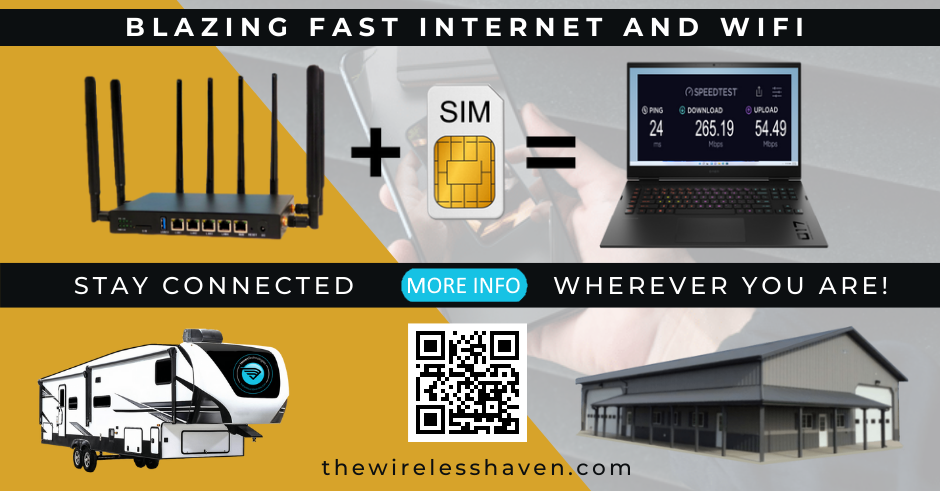OK, so I got around to finally doing some more testing with the EM7565 and Verizon. The results are quite interesting. Below are the results, but I've been able to determine for sure what bands are on the tower now. Please use below as the reference throughput this post.
Band 13 (750mhz / 10mhz wide)
Band 5 ( 850mhz / 5mhz wide)
Band 2 (1980mhz / 10mhz wide)
Band 4 (2120mhz / 20mhz wide)
Band 66 (2165mhz / 10mhz wide)
I started off testing in my office with just my upgraded 3dbi omni antennas attached to the modem. Please note too that the latest version of the firmware for the EM7565 has all the band names jacked up for some reason.
Screen Shot 2019-07-15 at 9.37.28 AM.png
Notice B2 was primary while band 4 and band 66 were assigned as CA.
I also took a screenshot while doing a speed test and all secondary carriers were active. I don't have a screenshot of the speed test but it was about 70mbps down with about 25mbps up.
Screen Shot 2019-07-15 at 9.52.35 AM.png
The screenshot above was outside on my deck with some extra 9dbi yagi antennas hooked up. I had tried outside on the deck with just the omnis with the same results. I thought maybe the higher gain antennas would give me a different band order, but it didn't. Also note during this screenshot I was doing a speed test and in this case only ONE of the secondary carriers was active. That speed test got me about 65mbps down with 25mbps up.
Screen Shot 2019-07-15 at 10.11.49 AM.png
I then put the EM7565 in my outdoor setup, and tried some more tests. As you can see same carrier configuration, and I could only get one carrier active while doing a speed test. Speed test was about the same at 65mbps down / 25 up.
So this is where it gets interesting. For some reason, I thought maybe I should try the modem in QMI mode rather than MBIM. I had seen some threads about latency issues in MBIM mode that were improved with QMI, so I thought what the heck, let me give it a shot.
Screen Shot 2019-07-15 at 6.06.28 PM.png
And bam! Suddenly now the modem selected Band 4 (even though it says Band 66) as primary with Band 2 and Band 66 as secondary carriers. I have literally no idea why QMI mode caused this to happen, but I did notice that I didn't get an IPv6 address while in QMI mode as well.
Screen Shot 2019-07-16 at 11.19.25 AM.png
Speed test while in QMI mode. I also saw on speedtest.com about 70mbps down and 45mbps up. The interesting thing here is that the MC7455 that I normally use, selects Band 4 as primary too, but band 5 as the secondary carrier (remember 7455 only supports 2 carriers while the EM7565 supports 3).
So in conclusion there's a few things.
1. In my case, the EM7565 doesn't seem to make much of a difference in performance for me, because I'm not getting aggregation of all three bands. I don't know if this is unique to this tower, or if how Verizon just setups their different bands. I did test this modem with AT&T sim, and it did aggregate all three of their bands together (B12,B2, and B30).
2. I really feel like I should be getting better download speeds. My AT&T sim on my outdoor setup can get 75mbps down on B12 and B2 and that tower is 5 miles away NLOS, and only has a SINR of 10mbps! I suspect this tower must be over loaded even though it was just upgraded, because when I was in downtown Atlanta standing near some Verizon small cells with the exact same bands, I was able to get 290mbps down and about 60mbps up on my Samsung S8. I even drove right next to the tower with my phone and couldn't get more than 80mbps down, so the tower is either totally limited or highly congested already.
Anyways, just thought I'd post that to share my experiences. Really interesting, kind of disappointed, but the upload is probably worth the extra expense of using Verizon over AT&T. My current upload with AT&T is only about 3-5mbps because B2 is primary and the tower is so far away.
It'll be quite interesting to see what happens when all the leaves fall off.
You do not have the required permissions to view the files attached to this post.


